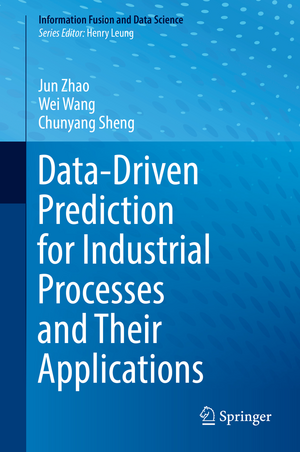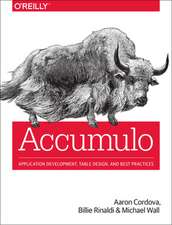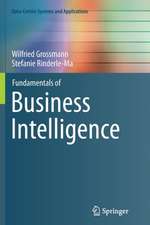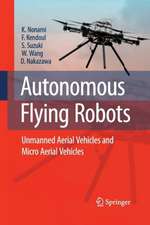Data-Driven Prediction for Industrial Processes and Their Applications: Information Fusion and Data Science
Autor Jun Zhao, Wei Wang, Chunyang Shengen Limba Engleză Hardback – 30 aug 2018
| Toate formatele și edițiile | Preț | Express |
|---|---|---|
| Paperback (1) | 824.32 lei 6-8 săpt. | |
| Springer International Publishing – 22 dec 2018 | 824.32 lei 6-8 săpt. | |
| Hardback (1) | 830.73 lei 6-8 săpt. | |
| Springer International Publishing – 30 aug 2018 | 830.73 lei 6-8 săpt. |
Preț: 830.73 lei
Preț vechi: 1038.41 lei
-20% Nou
Puncte Express: 1246
Preț estimativ în valută:
158.98€ • 165.36$ • 131.25£
158.98€ • 165.36$ • 131.25£
Carte tipărită la comandă
Livrare economică 14-28 aprilie
Preluare comenzi: 021 569.72.76
Specificații
ISBN-13: 9783319940502
ISBN-10: 3319940503
Pagini: 315
Ilustrații: XVI, 443 p. 167 illus., 128 illus. in color.
Dimensiuni: 155 x 235 mm
Greutate: 0.82 kg
Ediția:1st ed. 2018
Editura: Springer International Publishing
Colecția Springer
Seria Information Fusion and Data Science
Locul publicării:Cham, Switzerland
ISBN-10: 3319940503
Pagini: 315
Ilustrații: XVI, 443 p. 167 illus., 128 illus. in color.
Dimensiuni: 155 x 235 mm
Greutate: 0.82 kg
Ediția:1st ed. 2018
Editura: Springer International Publishing
Colecția Springer
Seria Information Fusion and Data Science
Locul publicării:Cham, Switzerland
Cuprins
Preface.- Introduction.- Why the prediction is required for industrial process.- Introduction to industrial process prediction.- Category of industrial process prediction.- Common-used techniques for industrial process prediction.- Brief summary.- Data preprocessing techniques.- Anomaly detection of data.- Correction of abnormal data.- Methods of packing missing data.- Data de-noising techniques.- Data fusion methods.- Discussion.- Industrial time series prediction.- Introduction.- Methods of phase space reconstruction.- Prediction modeling.- Benchmark prediction problems.- Cases of industrial applications.- Discussion.- Factor-based industrial process prediction.- Introduction.- Methods of determining factors.- Factor-based single-output model.- Factor-based multi-output model.- Cases of industrial applications.- Discussion.- Industrial Prediction intervals with data uncertainty.- Introduction.- Common-used techniques for prediction intervals.- Prediction intervals with noisy outputs.- Prediction intervals with noisy inputs and outputs.- Time series prediction intervals with missing input.- Industrial cases of prediction intervals.- Discussion.- Granular computing-based long term prediction intervals.- Introduction.- Basic theory of granular computing.- Techniques of granularity partition.- Long-term prediction model.- Granular-based prediction intervals.- Multi-dimension granular-based long term prediction intervals.- Discussion.- Parameters estimation and optimization.- Introduction.- Gradient-based methods.- Evolutionary algorithms.- Nonlinear Kalman-filter estimation.- Probabilistic methods.- Gamma-test based noise estimation.- Industrial applications.- Discussion.- Parallel computing considerations.- Introduction.- CUDA-based parallel acceleration.- Hadoop-based distributed computation.- Other techniques.- Industrial applications to parallel computing.- Discussion.- Prediction-based scheduling of industrial system.- Introduction.- Scheduling of blast furnace gas system.- Scheduling of coke oven gas system.- Scheduling of converter gas system.- Scheduling of oxygen system.- Predictive scheduling for plant-wide energy system.- Discussion.
Notă biografică
Jun Zhao is currently a Professor with the School of Control Science and Engineering, Dalian University of Technology, China.
Chunyang Sheng is currently a lecturer with the School of Electrical Engineering and Automation, Shandong University of Science and Technology, China.
Wei Wang is currently a Professor with the School of Control Science and Engineering, Dalian University of Technology, China.
Wei Wang is currently a Professor with the School of Control Science and Engineering, Dalian University of Technology, China.
Textul de pe ultima copertă
This book presents modeling methods and algorithms for data-driven prediction and forecasting of practical industrial process by employing machine learning and statistics methodologies. Related case studies, especially on energy systems in the steel industry are also addressed and analyzed. The case studies in this volume are entirely rooted in both classical data-driven prediction problems and industrial practice requirements. Detailed figures and tables demonstrate the effectiveness and generalization of the methods addressed, and the classifications of the addressed prediction problems come from practical industrial demands, rather than from academic categories. As such, readers will learn the corresponding approaches for resolving their industrial technical problems. Although the contents of this book and its case studies come from the steel industry, these techniques can be also used for other process industries. This book appeals to students, researchers, and professionals withinthe machine learning and data analysis and mining communities.
Caracteristici
Features data-driven modeling algorithms for different industrial prediction requirements Discusses multi-scale (short, median, long) prediction, multi-type prediction (time series and factor-based), and interval-based prediction Includes case studies based on real-world industrial predictions




































